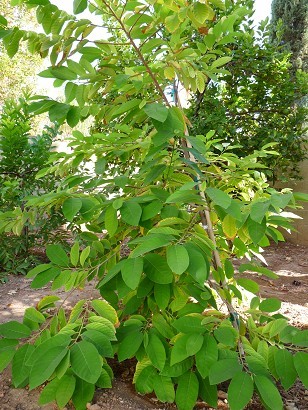|
 Photo
Photo
The atemoya tree pictured on the right is a variety called Gefner, and was photographed in October.
It was planted about a year and a half earlier in late March 2008.
I mail ordered it from Florida.
It is planted on the northeast
side of a large pine tree, about 6 feet from the pine trees drip line, so it gets
shade during the hottest part of the day. It still gets a reasonable amount of direct
sun the rest of the day.
This atemoya tree grows continously during warm weather
and sheds its leaves for a brief period in early spring. It is the second atemoya I have attempted.
The first one I tried was a variety called 48-26, a red fruited variety. It was a slow grower and
died in late winter. I believe that I probably watered it too much over the winter, because I
have read that atemoyas get root rot easily in cold weather when their roots are kept too wet. Therefore,
I turn off the water to my current Gefner atemoya during the winter, and only water it occasionally by hand,
maybe once a month, during the cold part of the year. It appears to be working, because the Gefner made it through
last winter without any problems.
This atemoya tree produces flowers starting in late spring, all through
summer, and into the fall. It has not fruited yet, but I have noticed that the flowers
are getting larger in size as the tree gets more established. Gefner atemoyas
are supposed to be able to set fruit without hand pollination. Most trees
do not produce fruit in their first two years so it is too early to tell
if hand pollination is necessary.
Overview
Atemoya trees are a cross between a sugar apple tree and a cherimoya tree.
Sugar apple trees are more adapted to hot tropical lowlands while cherimoya
trees are more adapted to a cool mountain climates and are more frost tolerant.
Combining these two trees results in a plant that has greater frost tolerance
than a sugar apple but more heat tolerance than a cherimoya, making it a good
candidate for Phoenix Arizona. Atemoyas grow well with small amounts of mild organic fertilizers
such as fish emulsion. Our heavy clay soil
prevents adequate aeration of the root system, so atemoyas do
better when large grained sand is mixed in during planting.
Heat Tolerance and Sun Exposure
Atemoya trees do better with some afternoon shade in the summer. Other than that they take the heat well,
as long as they are adequately watered.
Cold Tolerance
Being hardy to 29 F. atemoya trees should be covered when temperatures are predicted to be below freezing.
They should be watered much less during the winter because they are
susceptible to root rot during cold weather.
Planting
Dig a hole at least twice the size of the rootball. At a minimum, make the
hole 2 feet in diameter and 2 feet deep.
Back fill the whole with the same native soil that was removed,
and add several pounds of sand.
Be sure to mix the backfill as thoroughly as possible.
Atemoyas seem to become chlorotic easily,
so adding sand to the soil will improve air penetration into the soil and
help the roots to stay more healthy.
It also is a good idea to finish with the
hole an inch or two recessed so that a watering basin is formed.
After planting, spread a thin layer of compost on top
of the soil to help conserve moisture and to supply some nutrients.
Do not fertilize the newly planted tree until it has been vigorously growing for
a couple of months.
Watering frequency
Atemoyas do well on a grass watering schedule during the warm
and hot months. During the cold months, cut back on watering considerably. I turn off the water
to my atemoya during winter and hand water it every 3 to 4 weeks.
Watering method
Basin irrigation
is recommended because it helps keep the salt in our salty
water from accumulating around the roots. Furthermore, deep watering
will encourage the plant to develop deeper roots, making the plant tougher when the weather
gets hot and dry.
Fertilizing and Growth Rate
Atemoyas seem to be able to grow well even on poor soil, so little fertilizer is needed.
However, very small amounts can help speed up growth, but one must be careful because atemoyas
are somewhat salt sensitive.
Since the Phoenix area water is already high in salts,
the safest thing to do is to not use any chemical nitrogen fertilizers.
During the warm and hot months, infrequent applications of 5-1-1 fish emulsion
are beneficial. Avoid fertilizing the tree when
it is coming out of dormancy, which can take a long time in the spring. Wait until
the tree is covered with large healthy leaves.
Propagation
Select varieties of Atemoya are grafted. Since an atemoya is a very specific combination of two different trees, an
atemoya seedlings is very unlikely to be an atemoya.
Pests
No known pests in Phoenix Arizona.
Links to more Atemoya information
Atemoya - University Of Florida
Atemoya - Gene Joyner
Atemoya - Julia Morton
|
 Book the Phoenix Tropicals Condo on Kiahuna Beach, in Kauai, Hawaii
Book the Phoenix Tropicals Condo on Kiahuna Beach, in Kauai, Hawaii